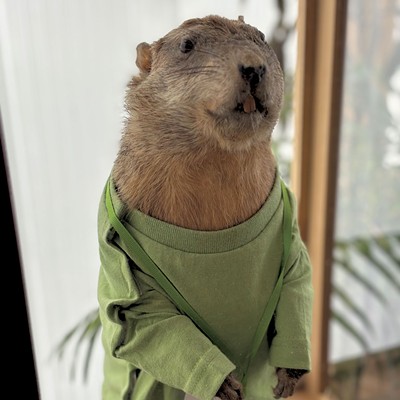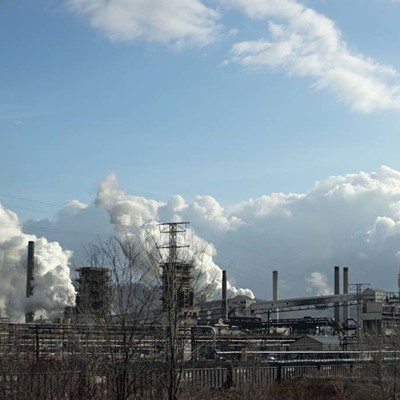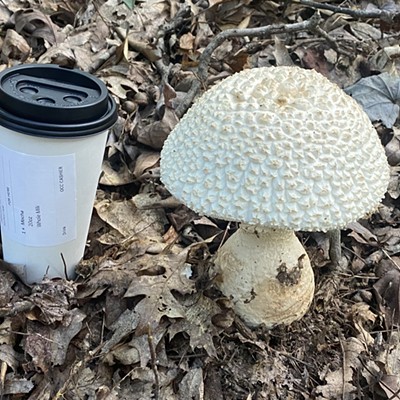The animals we eat were not made for close quarters. But for efficiency's sake, that's mostly how we raise our cows, pigs and chickens. One result is a heightened risk of disease and, for decades, the commonplace use of antibiotics.
Antibiotics are used to prevent and treat diseases, and also to speed the animals' growth. But, as in humans, antibiotic use also fosters the growth of bacteria resistant to one or more of these drugs — including the "superbugs" that are a big public-health concern worldwide.
The European Union was worried enough to ban all nontherapeutic uses of antibiotics on food animals. In the U.S., federal officials are working to limit such veterinary uses. But some observers want Euro-style restrictions here. On Feb. 5, environmental group Food & Water Watch held a press conference in Pittsburgh touting its campaign meant to protect antibiotics for human use.
"Save antibiotics for Pittsburgh families NOT factory farms," read a sign at the event. Because of antibiotic resistance, "We're continuing to run out of things we can treat those infections with," said guest speaker Dr. Betsy Blazek-O'Neill, of Allegheny General Hospital. Food & Water Watch backs bills in the U.S. House and Senate that would phase out nontherapeutic uses of "medically important antimicrobials" in animals. Field organizer Margaret Kran-Annexstein says the group is seeking a Pittsburgh City Council resolution on the issue, and will approach U.S. Sen. Bob Casey, who sits on the Senate Agriculture Committee.
How big a problem is antibiotic resistance? The federal Centers for Disease Control say antibiotic-resistant bacteria are responsible for 2 million infections and 23,000 deaths annually. But much resistance, perhaps most of it, results from antibiotic use in people: Many such infections are hospital-transmitted, and the CDC estimates that up to half of human prescriptions for antibiotics are unnecessary or inappropriate.
Even infections linked to animals are hard to pin down epidemiologically. True, resistant bacteria are widely found on raw meat in supermarkets. (So observe proper cooking and handling.) And the CDC estimates that resistant campylobacter, for instance, infects 310,000 people a year, and kills 28. But antibiotic use is ubiquitous, and fecal cross-contamination possibilities — on farms and processing plants, in groundwater and soil — are many. Tracing a particular infection to a particular dosage is almost impossible.
Supporters of tighter laws note that an estimated 80 percent of antibiotics sold in the U.S. are used on animals. "We know you can raise animals without this process," says Food & Water Watch assistant director Patty Lovera.
A decade ago, McDonald's began prohibiting its suppliers from using as growth-promoters antibiotics important in human medicine; Chick-fil-A recently announced a similar policy.
Meanwhile, opponents of stricter federal regulation — most vocally, pharmaceutical companies and big agriculture — contend that only a small percentage of antibiotic use is used to speed growth. They say antibiotics are mostly used for "disease prevention": "Studies indicate that the presence of foodborne bacteria increases when the use of antibiotics that help suppress animal diseases decreases," reads the website of the Animal Health Institute, a trade group for pharmaceutical manufacturers.
David Wolfgang, a Penn State agricultural-extension veterinarian, agrees. Wolfgang says the U.S. Food and Drug Administration's new voluntary guidelines limiting antibiotic use (and requiring more veterinary oversight) sufficiently protect public health without hindering farmers. He says the bigger problem is human misuse of antibiotics.
Opponents and supporters of stricter laws draw divergent lessons from European bans like Denmark's. Opponents note that while Danish pigs' overall antibiotic consumption plummeted after the late-1990s ban, more antibiotics — including some drugs important to humans — were used on sick animals. Supporters like the World Health Organization counter that the Danish ban reduced antimicrobial resistance among animals with no serious impact on animal health or meat production. Danish farmers with industrial-scale operations did have to provide a little more room per animal, plus better air circulation and different feed.
None of that would be news to Mike Kovach. His Mercer County operation, Walnut Hill Farm, raises pastured cows, pigs, chickens and turkeys in ways that reject industrial agriculture. "We've never used [antibiotics], period," Kovach says. "We never have a need for them, because [the animals] are out eating what they evolved to eat."














